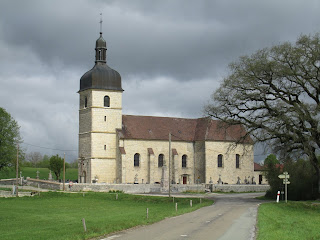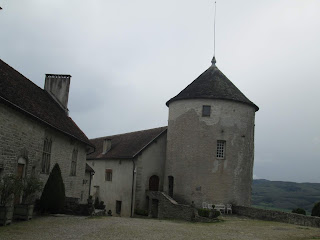On Tuesday morning we left Chateauneuf-en-Auxois and drove towards Switzerland, where we would be spending the next 4 days. We made a brief stop across the road from Chateau de Joux, and had a picnic at the same spot we had done so 3 or 4 years ago. I hadn’t realized that we were going to pass the same way we did then, but Chateau de Joux is near the Swiss-French border, and it overlooks the pass from Italy to France via Switzerland.
 |
| Chateau de Joux |
The border crossing took no time, as France and Switzerland are part of the Schengen zone, with no passport control, and while there is Customs because Switzerland is not part of the EU, we were waved through. We then drove on towards the city of Bern, where we were spending 2 nights at an apartment. We left our car at a park and ride on the outskirts, and took a bus and walked to our apartment. It was in a building that borders the Aare River, which meanders through Bern. After checking in, we took a walk across the river into the center of Bern, and made several stops, including a wine bar and a grocery store to pick up some provisions for dinner and breakfast. We also walked by the famous clock tower, which has figurines that parade in a circle and also clang the bells on the hour. That evening we had dinner outside in the courtyard of our apartment.
 |
| View of Bern from Above |
The next morning we first headed out to the Bear Park, which was only about a 10 minute walk from our apartment. Bern has a long historical connection with bears, and the Bear Park is a big tourist attraction, being home to 3 bears at the moment who have free reign over a good amount of territory near the Aare River. After seeing the bears, we took a long walk to the Bern Zoo, where we spent a couple of hours.
We then took a bus from the zoo to the center, and stopped at an outdoor market and picked up some local cheese and air-dried beef, which is a specialty of this area. We also stopped at a shop that stocked wine, and we picked up a bottle of Swiss white wine to have with lunch at our apartment. We then walked back to our place, and since the weather was so nice we had lunch in the courtyard.
In the afternoon we did a lot of walking, spending some time at the huge cathedral that dominates the Bern skyline. While the cathedral dates from the medieval period, it was only in the last couple of hundred years that it was extended upward to tower over the city. Afterwards we walked around the center of Bern again, then wound up stopping in the wine bar section of a Spanish restaurant along the Aare River. We had a few glasses of Swiss white wines, along with a huge tapas platter that became our dinner.
The next day we left Bern and headed towards the canton of Valais, Switzerland’s premier wine region, where we were staying in the town of Sierre. But first we stopped in the village of La Gruyeres, a medieval village with a spectacular chateau that was built in the 13th century. We spent quite a bit of time touring the chateau, then stopped at La Maison de Gruyeres and picked up some Gruyeres cheese, which we had as part of a picnic lunch.
We arrived in Sierre in the late afternoon, and Christine, the owner of the B&B, was there to greet us. She and her husband live next door to the B&B, which used to be part of their home. It’s all part of a small complex on the outskirts of Sierre, looking towards the mountains. They also have a small farm in the mountains where, among other things, they make wine from grapes they grow in Sierre and around the farm. We joined them for one of their white wines, an unlabelled Johannisberg (AKA Sylvaner), which was superb.
 |
| Chateau Mercier |
In the early evening we went to the nearby Chateau de Villa, which has a restaurant as well as a wine bar. The wine bar opens early, and at 6 p.m. it was already very busy. The main room was full, but we sat at a table in one of the adjoining rooms, which was stacked with hundreds of Swiss wines for sale. The list of wines by the glass changes every week, and normally has about 8-10 wines, split between red and white. We tried all 4 whites, which were made from the Chasselas, Johannisberg, Petite Arvine, and Muscat grapes respectively, and one red, a Syrah. All were good, but I preferred the whites. With the wines we ordered a small platter of 5 different cheeses from the Valais, and a large platter of air-dried meat from 3 different local producers. It was very interesting to taste the differences in the cheeses and between the meats.

The next morning we walked towards the center of Sierre and to the train station, about a 15 minute walk. We had read about a large weekly market in nearby Sion, and decided to go there by train rather than driving. The train runs very frequently, and only took around 10-15 minutes to get to Sion. We walked towards the center of Sion and easily found the market, which stretched throughout the center of town. We bought some food items for the next leg of our trip, including asparagus, which had just come into season in the Valais. We also made a brief stop at a wine bar next to the market, and tried 2 more white wines from the Valais.


After leaving the market we walked back towards the train station and returned to Sierre. We had a light lunch on the patio, then I went to ask Christine if she would mind calling the winemaker down the road and see about setting up a visit for us at his small winery. It turned out that he was away for the day, so she then called another winery she knew well in a nearby town, Salgesch, and said she would drive us there for a visit. Salgesch is a village of winegrowers about 10 minutes from Sierre, and our first stop was at Cave St. Philippe, a small family run operation. The husband and wife who run the winery were away in Bern at a wine show, but their daughter was filling in for them, and she gave us a brief tour and then poured several wines for us to try. The wines were very good, especially the whites, and we bought a couple of bottles. Christine then asked if we wanted to visit a larger operation just down the road, which she said was very good. Of course we couldn’t turn down her offer, so we all went to Cave Nouveau Salquenen, which has a beautiful set up for tasting and makes an amazing array of wines. We tried about 10 wines, and most of them were superb. Among the wines we tried were ones made from several unique Swiss grape varieties, including Amigne de Vetroz, Humagne Blanche, Petite Arvine, Humagne Rouge, and Cornalin. We bought half a dozen different wines to fortify us during the next week.
 |
| Barrels and Wine Press at Cave St. Philippe |
That night we walked to the Chateau de Villa again, this time to go to their restaurant. The restaurant is actually a pretty low-key place, which specializes in Raclette. Like us, most of the people there ordered the Raclette special, which consists of Raclette from 5 different producers in the Valais, brought to your table on a plate by the Raclette Master, one cheese at a time. It’s all you can eat, but the best I could do was have 2 more cheeses after the first round. It was a superb way to spend our last night in Sierre.































































